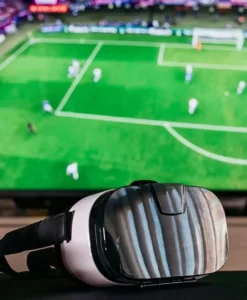Virtual Reality VR game development headsets have revolutionized how we experience games and other digital content. VR technology has made it possible to create immersive and interactive gaming experiences that were previously unimaginable.
However, not all VR headsets are created equal when it comes to game development. Game developers must consider various compatibility factors when choosing a VR headset, including tracking, controllers, resolution, refresh rate, the field of view, and system requirements.
This article will explore the most compatible VR headsets for game development and examine their features, pros, and cons.
Importance Of Compatibility With VR Game Development
Virtual Reality (VR) is an exciting technology that has overtaken the gaming industry. It immerses users in an interactive 3D environment, making them feel part of the game world.
However, VR game development is a complex process that requires careful consideration of several factors, including compatibility. Compatibility is crucial to VR game development because it ensures that the game can run smoothly on various hardware configurations and platforms, providing an optimal user experience.
One of the main reasons compatibility is important in VR game development is the wide range of hardware configurations available on the market. VR games require a lot of processing power, and not all computers or gaming consoles can deliver the required performance. Developers must ensure their game is compatible with various hardware configurations, including minimum and recommended specifications. This allows the game to reach a wider audience and ensures users have a seamless experience regardless of their hardware.
Another reason compatibility is important in VR game development is the need to support multiple platforms. VR games can be played on various devices, including VR headsets, gaming consoles, and PCs. Each platform has unique requirements, and developers must ensure their game is compatible. +This helps expand the game’s audience and ensures that users can choose the best platform.
Compatibility is also important in VR game development because it helps to reduce technical issues and improve performance. When a game is incompatible with a particular hardware configuration or platform, it may experience technical issues such as lagging, stuttering, or crashes.
These issues can significantly impact the user experience and may cause frustration or disappointment. By ensuring that the game is compatible with a wide range of hardware configurations and platforms, developers can reduce the likelihood of these issues occurring and provide a smooth and seamless user experience.
Finally, compatibility is essential in VR game development because it helps to future-proof the game. The gaming industry constantly evolves, and new hardware configurations and platforms are regularly introduced.

By ensuring that the game is compatible with a wide range of configurations and platforms, developers can ensure that the game will continue to be relevant and playable for years. This helps to extend the game’s lifespan and ensures that users will continue to enjoy it long after its initial release.
In conclusion, compatibility is a crucial aspect of VR game development. It ensures the game can run smoothly on various hardware configurations and platforms, expands its audience, reduces technical issues, and future-proofs the game. Developers must carefully consider compatibility when creating VR games to ensure users have a seamless and enjoyable experience regardless of their hardware or platform.
Compatibility Factors To Consider
Virtual Reality VR game development is a complex process that requires careful consideration of various compatibility factors. These factors are essential to ensure the game runs smoothly on various hardware configurations and platforms, providing an optimal user experience.
In this article, we will discuss some key compatibility factors developers must consider when creating VR games.
1. Hardware Compatibility.
Hardware compatibility is one of the most important factors when creating a VR game. VR games require a lot of processing power, and not all computers or gaming consoles can deliver the required performance.
Developers must ensure their game is compatible with various hardware configurations, including minimum and recommended specifications. This allows the game to reach a wider audience and ensures users have a seamless experience regardless of their hardware.
2. Platform Compatibility.
VR game development can be played on various devices, including VR headsets, gaming consoles, and PCs. Each platform has unique requirements, and developers must ensure their game is compatible.
This helps expand the game’s audience and ensures that users have the flexibility to choose the platform that works best for them.
3. Software Compatibility.
Software compatibility is another essential factor when creating a VR game development. Developers must ensure their game is compatible with various operating systems, drivers, and game engines. This helps to reduce technical issues and improve performance.
When a game is incompatible with a particular software configuration, it may experience technical issues such as lagging, stuttering, or crashes. These issues can significantly impact the user experience and may cause frustration or disappointment.
4. Input Devices Compatibility.
Input device compatibility is an important factor to consider when creating a VR game. VR games require different types of input devices, such as hand controllers, keyboards, and mice.
Developers must ensure that their game is compatible with various input devices, allowing users to choose the input method that works best for them. This helps to enhance the user experience and ensures that users have a more immersive and enjoyable experience.
5. Accessibility Compatibility.
Accessibility compatibility is another essential factor to consider when creating a VR game. Developers must ensure their game is accessible to many users, including those with disabilities.
This may include adjustable text size, colorblind modes, and alternative input methods. By ensuring that their game is accessible to a wider range of users, developers can expand their audience and provide a more inclusive gaming experience.
In conclusion, compatibility factors are crucial to VR game development. Developers must carefully consider hardware, platform, software, input devices, and accessibility compatibility when creating VR games to ensure that users have a seamless and enjoyable experience regardless of their hardware or platform.
By considering these factors, VR game development developers can create VR games that reach a wider audience, reduce technical issues, and provide a more immersive and inclusive gaming experience.
Oculus Rift: Compatible Vr Headset For Game Development
Oculus Rift is a virtual reality headset that has become popular among game developers due to its compatibility with VR game development. One of the reasons for its popularity is its hardware compatibility. The headset is compatible with various hardware configurations, including high-end PCs and gaming laptops. This makes it an ideal choice for developers who want to create VR games for a wide audience with different hardware configurations.
In addition to hardware compatibility, Oculus Rift is also compatible with various VR game development platforms. It is a standalone VR headset compatible with the Oculus, a content distribution platform that hosts a wide range of VR games and experiences.
Furthermore, the platform is also compatible with other VR headsets, such as the Oculus Quest and Quest 2. This allows developers to create VR games for Oculus Rift that can be played on other compatible VR headsets, further expanding the game’s reach and audience. Oculus also provides a software development kit (SDK) and a range of tools that make it easier for developers to create VR games for Oculus Rift. The SDK provides developers with the necessary tools to create VR games optimized for the Oculus platform, including features such as real-time analytics and performance monitoring.

Additionally, Oculus provides various tools that allow developers to create high-quality graphics and immersive environments for their games, such as Oculus Medium and Oculus Quill. Another reason Oculus Rift is a compatible VR headset for game development is its community. The Oculus community is a large and active community of developers, gamers, and enthusiasts passionate about VR technology.
This community provides developers many resources, including forums, tutorials, and developer support. This makes it easier for developers to create VR games for Oculus Rift and receive feedback from the community on their work.
Lastly, Oculus Rift offers a high-quality VR experience unmatched by other VR headsets. Its high-resolution display and precise tracking make it an ideal choice for creating immersive VR games. The headset also features integrated audio that provides a more immersive experience and eliminates the need for separate headphones.
In conclusion, Oculus Rift is a compatible VR headset for game development due to its hardware compatibility, platform compatibility, SDK and tools, active community, and high-quality VR game development experience. These factors make it an ideal choice for developers who want to create immersive VR games that reach a wide audience and provide an optimal user experience.
Htc Vive: Compatible Vr Headset For Game Development
HTC Vive is another popular virtual reality (VR) headset compatible with game development. It was developed in collaboration with Valve Corporation and was one of the first VR headsets to offer room-scale VR.
This article will discuss why HTC Vive is a compatible VR headset for game development.
1. Room-Scale VR
One of the key features of the HTC Vive is its room-scale VR capabilities. This means that the headset can track the user’s movements in a physical space and allow them to move around in a virtual environment. This feature is ideal for creating immersive.
VR game development requires physical movement and interaction with the environment. It also allows for more realistic gameplay and a more immersive experience.
2. Sdk And Tools
HTC Vive provides a software development kit (SDK) and a range of tools that make it easier for developers to create VR games for the headset. The SDK provides developers with the necessary tools to create VR games optimized for HTC Vive and take advantage of its room-scale VR capabilities.
HTC provides various tools that allow developers to create high-quality graphics and immersive environments for their games, such as the SteamVR Unity Plugin.
3. Platform Compatibility
HTC Vive is compatible with the SteamVR platform, which is a VR content distribution platform that hosts a wide range of VR games and experiences. The platform is compatible with other VR headsets, including the Oculus Rift and Windows Mixed Reality.
This allows developers to create VR games for HTC Vive that can be played on other compatible VR headsets, further expanding the game’s reach and audience.
4. Hardware Compatibility
HTC Vive requires a high-end PC with a powerful graphics card to run smoothly. However, it is compatible with a wide range of hardware configurations, making it an ideal choice for game developers who want to create VR games for a wide audience with different hardware configurations.
In conclusion, HTC Vive is a compatible VR headset for game development due to its room-scale VR capabilities, SDK and tools, platform compatibility, and hardware compatibility. These factors make it an ideal choice for developers who want to create immersive VR games that take advantage of the headset’s unique features and reach a wide audience.
Valve Index: Compatible Vr Headset For Game Development
Valve Index is a virtual reality (VR) headset developed by Valve Corporation, the same company behind the SteamVR platform. The headset is designed to provide a high-quality VR experience and is a popular choice among game developers. This article will discuss why Valve Index is a compatible VR headset for game development.

1. High-Quality Display And Audio
Valve Index features a high-resolution display that provides a clear and detailed VR experience. It also has a high refresh rate, which helps to reduce motion sickness and improve the overall VR game development experience. The headset also features integrated headphones that provide a high-quality audio experience and eliminate the need for separate headphones.
2. Precise Tracking.
Valve Index features precise tracking, allowing more accurate movement and interaction in a virtual environment. The headset uses a combination of cameras and sensors to track the user’s movements, which allows for more natural and intuitive gameplay. The precise tracking also allows for more complex VR games that require more precise movements and interactions.
3. Sdk And Tools.
Valve Index provides a software development kit (SDK) and a range of tools that make it easier for developers to create VR games for the headset.
The SDK provides developers with the necessary tools to create VR games optimized for the Valve Index and take advantage of its unique features. Additionally, Valve provides a range of tools that allow developers to create high-quality graphics and immersive environments for their games.
4. Platform Compatibility.
Valve Index is compatible with SteamVR, a VR content distribution platform hosting various VR games and experiences. The platform is compatible with other VR headsets, including the HTC Vive and Oculus Rift. This allows developers to create VR games for Valve Index that can be played on other compatible VR headsets, further expanding the game’s reach and audience.
In conclusion, Valve Index is a compatible VR headset for game development due to its high-quality display and audio, precise tracking, SDK and tools, and platform compatibility. These factors make it an ideal choice for developers who want to create immersive VR games that take advantage of the headset’s unique features and reach a wide audience.



